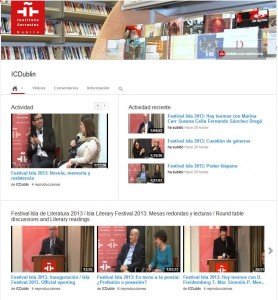Blog del Instituto Cervantes de Dublín
Torre Martello
Galicia en Irlanda / Galicia in Ireland
Cuenta la mitología irlandesa que el druida y poeta Amergin, hijo de Míl de Hispania, cruzó el mar desde Galicia para establecerse en tierras irlandesas. Varios cientos de años después, el Instituto universitario de estudios irlandeses Amergin, de la Universidad de A Coruña, recupera la memoria del antiguo druida y de este primer nexo de unión gallego-irlandesa. Más allá de eso, el Instituto Amergin promueve la investigación sobre temas irlandeses y especialmente sobre el acercamiento entre dos culturas que comparten tanto en común.
Si quieres saber más sobre la labor del Instituto y cómo se inscriben los estudios sobre Irlanda en el contexto gallego, no dudes en acercarte esta tarde al simposio “Galicia en Irlanda”, que tendrá lugar a las 6 de la tarde en el Café Literario. Tanto la presentación como las intervenciones de los ponentes serán en inglés.
Os dejamos la canción de Amergin, el druida celta que fue gallego y también irlandés:
According to the Irish mythology, the druid and poet Amergin, son of Míl de Hispania, crossed the sea from Galicia to settle in Irish lands. A few hundred years later, the University Institute of Irish Studies Amergin, of theUniversity ofA Coruña, brings back the memory of the old druid and this first link betweenIreland andGalicia. Furthermore, the Institute Amergin promotes the research about Irish topics and specially about the links between these two cultures which have a lot in common.
If you want to know more about the Institute’s work and how the Irish studies are approached in the Galician context, don’t hesitate to come this afternoon to the symposium ‘Galicia in Ireland‘. It will take place at 6 pm at Café Literario. Both the presentation and the lecture will be in English.
We let you enjoy the song of Amergin, the celt druid who was Galician and Irish: click on the video above.
Safeguarding Intangible Cultural Heritage
 No doubt you are well aware of the rudiments of flamenco, of how to dance a tango, and you will almost certainly have heard of the advantages of a Mediterranean diet.
No doubt you are well aware of the rudiments of flamenco, of how to dance a tango, and you will almost certainly have heard of the advantages of a Mediterranean diet.
Perhaps you might also have heard of the human towers in Catalonia, or the Day of the Dead festivities in Mexico, and perhaps even the quirky displays of Barranquilla’s Carnival, in Colombia.
But, do you know what Majorca’s Chant of the Sybil is, or what it sounds like? Or the Whistled language of the island of La Gomera (one of the Canary Islands)? How about the Scissors Dance in Peru?
Each of these cultural practices has something in common: they are all part of UNESCO’s list of Intangible Cultural Heritage.
If you would like to find out more about any of these cultural phenomena, the following is a full list of those taking place in Spanish-speaking countries around the world:





